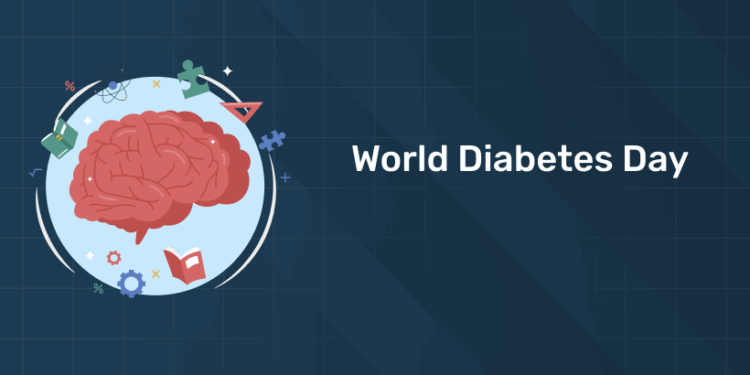Table of Contents
Diabetes is one of the most dreaded diseases humankind has ever faced in history. The world observes Diabetes day on November 14 every year. This day is observed as world diabetes day with the objective of raising awareness against the disease diabetes. In this article, you can find more information regarding Diabetes day and the disease that will help you with your competitive exam preparation.
World Diabetes Day 2025 Date – November 14
In this article readers can get a glimpse on
- History of World Diabetes Day
- World Diabetes Day Theme 2025
- World Diabetes Day Quiz
World Diabetes Day: History
1: Who was the first woman President of India?
Diabetes is a silent killer that takes life gradually. World Diabetes Day was launched in 1991 by the International Diabetes Federation and the World Health Organization (WHO) in response to the rapid rise of diabetes around the world. Certain studies that have been done across the world have shown that most of the population across the globe suffer from a type of diabetes. The International Diabetes Federation in the year 1991 with the collaboration of the World Health Organization started observing November 14 as World Diabetes Day. By 2016, World Diabetes Day was being commemorated by over 230 IDF member associations in more than 160 countries and territories, as well as by other organizations, companies, healthcare professionals, politicians, celebrities, and people living with diabetes and their families. World Diabetes Day became an official United Nations Day in 2006 with the passage of United Nations Resolution 61/225. It is marked every year on 14 November, the birthday of Sir Frederick Banting, who co-discovered insulin along with Charles Best in 1922.
Free UPSKILLING Courses!
Take your first step toward mastering in-demand skills, acing interviews, and securing top-tier jobs with Entri's free upskilling courses.
Start Learning!World Diabetes Day Theme 2025
The official theme for World Diabetes Day 2025 is “Diabetes across life stages” or “Diabetes during the life course.”
This theme emphasizes:
- That diabetes can affect people at every stage of life (childhood, adolescence, working age, older adulthood).
- The need for integrated care and supportive environments across all life stages.
World Diabetes Day Previous Themes
World Diabetes Day (WDD) is observed annually on November 14th, the birthday of Sir Frederick Banting, who co-discovered insulin in 1922. The campaign is led by the International Diabetes Federation (IDF) and is officially recognized by the United Nations.
The themes are often multi-year campaigns to ensure sustained focus and advocacy. The WDD campaigns often align with the IDF’s three-year focus periods.
- 2024: Breaking Barriers, Bridging Gaps (Part of the “Diabetes and Well-being” umbrella theme)
- Focus: Addressing the physical, societal, and mental well-being of people living with diabetes and fighting stigma, discrimination, and lack of support.
- 2023: Access to Diabetes Care
- Context: This was the final year of a three-year campaign (2021–2023) focusing on access to diabetes care.
- 2022: Access to Diabetes Education
- Context: Highlighting the critical role of education for healthcare professionals and people with diabetes in achieving optimal management.
- 2021: Access to Diabetes Medicines and Care
- Context: Launched the three-year campaign, emphasizing that millions of people with diabetes do not have access to essential insulin, oral medicines, self-monitoring equipment, and education.
- 2020: The Nurse and Diabetes
- Focus: Recognized the vital role of nurses and other health professionals in supporting people with diabetes, particularly during the COVID-19 pandemic.
- 2019: The Family and Diabetes
- Focus: Encouraged families to learn about the warning signs of diabetes and support the healthy lifestyle choices of their relatives.
- 2018: The Family and Diabetes
- Context: This was the first year of a two-year theme (2018–2019) emphasizing the role of the family in the prevention, early diagnosis, and care of diabetes.
- 2017: Women and Diabetes: Our right to a healthy future
- Focus: Highlighted the specific health risks faced by women with diabetes, including gestational diabetes, and the need for equitable access to care.
- 2016: Eyes on Diabetes
- Focus: Screenings were key, emphasizing the importance of early diagnosis and treatment to reduce the risk of serious complications like diabetic retinopathy (eye damage).
- 2015: Healthy Living and Diabetes
- Focus: Promoted physical activity and healthy eating as the core pillars of both preventing Type 2 diabetes and managing all types of diabetes.
- 2014: Go Blue for Diabetes (The underlying theme was Healthy Living and Diabetes)
- Focus: A general call to action to raise awareness about the risks and complications of diabetes through global activities, often symbolized by the Blue Circle logo.
Diabetes: All you need to know
Diabetes mellitus, commonly known as diabetes, is a metabolic disease that causes high blood sugar. The hormone insulin moves sugar from the blood into your cells to be stored or used for energy. With diabetes, your body either doesn’t make enough insulin or can’t effectively use the insulin it does make. There are different types of Diabetes identified in patients. Here are the details regarding a different kind of diabetes.
- Type 1 diabetes is an autoimmune disease. The immune system attacks and destroys cells in the pancreas, where insulin is made. It’s unclear what causes this attack. About 10 percent of people with diabetes have this type.
- Type 2 diabetes occurs when your body becomes resistant to insulin, and sugar builds up in your blood.
- Prediabetes occurs when your blood sugar is higher than normal, but it’s not high enough for a diagnosis of type 2 diabetes.
- Gestational diabetes is high blood sugar during pregnancy. Insulin-blocking hormones produced by the placenta cause this type of diabetes.
Symptoms
When a person is affected by diabetes, several symptoms also arise. Here are some of the most common symptoms of Diabetes.
- Increased hunger
- Increased thirst
- Weight loss
- Frequent urination
- Blurry vision
- Extreme fatigue
- Sores that don’t heal
Diabetes: Causes
Different reasons can be underlined as the cause of diabetes in human beings. The given below are some of the most common causes of diabetes.
Type 1 diabetes
Doctors don’t know exactly what causes type 1 diabetes. For some reason, the immune system mistakenly attacks and destroys insulin-producing beta cells in the pancreas.
Genes may play a role in some people. It’s also possible that a virus sets off the immune system attack.
Type 2 diabetes
Type 2 diabetes stems from a combination of genetics and lifestyle factors. Being overweight or obese increases your risk too. Carrying extra weight, especially in your belly, makes your cells more resistant to the effects of insulin on your blood sugar.
This condition runs in families. Family members share genes that make them more likely to get type 2 diabetes and to be overweight.
Gestational diabetes
Gestational diabetes is the result of hormonal changes during pregnancy. The placenta produces hormones that make a pregnant woman’s cells less sensitive to the effects of insulin. This can cause high blood sugar during pregnancy.
Women who are overweight when they get pregnant or who gain too much weight during their pregnancy are more likely to get gestational diabetes.
Diabetes: Common Risk Factors
Risk factors for diabetes depend on the type of diabetes. Several risk factors of diabetes include;
- Family History
- Environmental factors
- Food Habits
- Age
- The presence of damaging immune system cells
- Inactivity
- Weight
- High blood pressure
Diabetes: Complications
- Cardiovascular disease
- Nerve damage (neuropathy)
- Kidney damage (nephropathy)
- Eye damage
- Foot damage
- Skin conditions
- Hearing impairment
- Alzheimer’s disease
- Depression
Diabetes: Tips to prevent
- Regular physical activity
- Eat healthy food
- Lose extra weight
- Drink water as your primary beverage
- Follow a high fiber diet
Surprising Facts of Diabetes
- India has the world’s highest diabetes population with over 212 million people with diabetes.
- Diabetes is the 7th leading cause of death in the United States (and maybe underreported).
- In the last 20 years, the number of adults diagnosed with diabetes has more than doubled as the American population has aged and become more overweight or obese.
- 96 million US adults—over a third—have prediabetes, and more than 8 in 10 of them don’t know they have it.
- Eating sugar does not cause diabetes. But you should still cut back on sweets and sugary beverages.
- 80% of diabetes deaths are now occurring in low- and middle-income countries.
- In women, diabetes impacts estrogen levels, menstrual and ovulation cycles, and sexual desire.
- Clinical research found that babies who breastfeed for at least three months had a lower incidence of Type 1 diabetes and may be less likely to become obese as adults.
- Approximately 17 million U.S. residents have been diagnosed with diabetes, which is nearly 10% of the estimated 170 million people suffering from diabetes worldwide.
- The death rate among African-Americans with diabetes is 27% higher than among whites with diabetes. Reasons include hereditary, socio-economic issues, higher obesity rates, and lack of available health insurance or insurance coverage.
- Every 7 seconds one person dies from diabetes.
Free UPSKILLING Courses!
Take your first step toward mastering in-demand skills, acing interviews, and securing top-tier jobs with Entri's free upskilling courses.
Start Learning!World Diabetes Day Quiz 2025
A) Type 1
B) Type 2
C) Gestational
3. What is the main hormone responsible for regulating blood sugar?
A) Insulin
B) Adrenaline
C) Cortisol
A) Liver
B) Pancreas
C) Kidney
5. What is a common symptom of high blood sugar levels?
A) Frequent urination
B) Slow heartbeat
C) Muscle cramps
A) Fasting glucose test
B) HbA1c test
C) Blood pressure test
A) Regular exercise
B) Skipping breakfast
C) Sleeping less
A) Red
B) Green
C) Blue
A) World Health Organization
B) International Diabetes Federation
C) United Nations
Want More Engaging Questions?
Download our FREE PDF packed with insightful quiz questions to test your knowledge!
🔽 Click below to get your free copy now! 🔽
World Diabetes Day Quiz 2025 PDF
International Mother Language Day is more than just a celebration; it is a call to preserve linguistic diversity and promote multilingual education. As we honor the richness of languages worldwide, we also recognize their role in fostering cultural identity, inclusion, and sustainable development. This day reminds us of the importance of protecting endangered languages and ensuring that future generations can connect with their heritage.
Let us continue to embrace and promote mother languages, not only on February 21 but throughout the year, to build a more inclusive and linguistically diverse world. Together, we can keep languages alive and celebrate the beauty of communication in all its forms.
Free UPSKILLING Courses!
Take your first step toward mastering in-demand skills, acing interviews, and securing top-tier jobs with Entri's free upskilling courses.
Start Learning!Frequently Asked Questions
What is World Diabetes Day and why is it observed?
World Diabetes Day is observed every year on November 14 to raise global awareness about diabetes. It marks the birthday of Sir Frederick Banting, who co-discovered insulin in 1921. The day focuses on prevention, management, and care for those affected by diabetes. It is led by the International Diabetes Federation (IDF) and recognized by the World Health Organization (WHO). The event unites millions worldwide to highlight the growing concerns about diabetes.
Who founded World Diabetes Day?
World Diabetes Day was created by the International Diabetes Federation (IDF) and the World Health Organization (WHO) in 1991. It was introduced in response to the rising cases of diabetes across the world. The United Nations later recognized it as an official day in 2006. It aims to promote global education and awareness about diabetes. The founders hoped to encourage better prevention and treatment strategies globally.
Why is November 14 chosen for World Diabetes Day?
November 14 is the birthday of Sir Frederick Banting, who discovered insulin. His discovery revolutionized diabetes treatment, saving millions of lives. The date honors his contribution to medical science and diabetes care. It symbolizes hope and progress in diabetes management. Each year, the day reminds the world of the importance of continued research and awareness.
What is the main goal of World Diabetes Day?
The main goal is to raise awareness about diabetes prevention, care, and management. It encourages people to adopt healthier lifestyles and get regular health checkups. Governments and organizations also use the day to promote diabetes education programs. It seeks to reduce the burden of diabetes-related complications through awareness. The goal is to ensure early diagnosis and better access to medical care worldwide.
How is World Diabetes Day observed globally?
World Diabetes Day is marked through awareness campaigns, health checkups, and educational events. People participate in walks, screenings, and community talks about diabetes. Landmarks around the world are illuminated in blue to show support. Healthcare institutions conduct free testing and workshops. Schools and organizations also spread awareness through posters and social media.
What are the main types of diabetes?
The three main types of diabetes are Type 1, Type 2, and gestational diabetes. Type 1 occurs when the body stops producing insulin. Type 2 happens when the body becomes resistant to insulin. Gestational diabetes develops during pregnancy but may resolve after childbirth. Each type requires careful monitoring and different management approaches.
What are some common symptoms of diabetes?
Common symptoms include frequent urination, excessive thirst, and unexplained weight loss. People may also experience fatigue, blurred vision, and slow-healing wounds. These symptoms result from high blood sugar levels in the body. Early detection of these signs helps prevent complications. Regular blood sugar testing is essential for those at risk.
How can diabetes be prevented?
Diabetes can often be prevented through healthy lifestyle choices. Regular exercise, balanced diets, and maintaining a healthy weight are key. Avoiding sugary foods and processed items also helps control blood sugar. Regular medical checkups help in early detection and prevention. Managing stress and getting enough sleep further reduce the risk.
What is the significance of the blue circle symbol for World Diabetes Day?
The blue circle represents unity in the global fight against diabetes. Blue stands for the color of the United Nations flag, symbolizing global cooperation. The circle signifies life, health, and the shared effort to combat diabetes. It serves as a reminder that diabetes affects millions worldwide. The symbol encourages unity and hope for better health outcomes.
How does World Diabetes Day help people with diabetes?
World Diabetes Day spreads awareness and educates people on how to manage diabetes effectively. It highlights the importance of regular checkups, insulin access, and healthy lifestyles. The event encourages governments to strengthen healthcare support for patients. It also helps reduce stigma by promoting understanding and empathy. Overall, it empowers individuals to take control of their health and live better lives.













